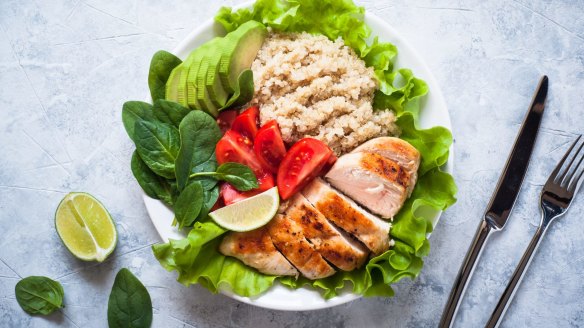How to nudge yourself towards healthier eating

The nudge theory – the art of small, subtle changes – now has a scientific status and you can use it to improve your eating habits.
Over 12 weeks, 14 workplace cafeterias in the Netherlands underwent a "nudge makeover" that involved 14 small changes to the food service environment, such as always having fruit and vegetables available, "better choices" in every food category, cash register food displays repeatedly advertising healthier options, and offering water for free.
The results published in the American Journal of Clinical Nutrition, confirm that sales of healthier sandwiches, healthier cheese as sandwich fillings, and fruit all increased and then stayed constant during the study.
Small positive changes appear to stick, without making a change to a person's autonomy in making food choices. So how do you give your whole eating routine a "nudge" makeover?
When Corrie Van put on 30 kilograms during her second pregnancy, she made small changes to her eating habits, one meal at a time.
Breakfast was the first: "I chose three breakfast meals that I liked, were easy to prepare and achievable, and for a month just implemented these without worrying about any of the other meals. Once a healthy breakfast became a habit I moved on to snacks," she says.
"I began buying a smaller chocolate instead of the family block for the first week. On week two, I chose a sweet fruit, like orange or grapes, and had them twice a week instead of chocolate. On week three, fruit was my go-to sweet for four days and by the end of the month I was no longer craving chocolate as much as sweet fruits, so I cut it out altogether."
Lunch was easier to implement as a healthy habit over a six-week period with a protein balanced salad sandwich or wrap, but dinner was the most challenging meal to change.
"The last thing I wanted to do after working a full day was to come home and cook dinner, so it had to be simple. I scanned through a list of simple meals that my husband or I would be happy to make, and we came up with basic meat and vegetable recipes, think tacos, wraps and stir-fries, and we would make enough to last two nights.
"It took well over six months of trying, failing and trying again, but in the end I succeeded to get rid of the weight and keep it off."
Accredited practising dietitian Georgia Bevan agrees that focusing on one behavioural-based goal at a time is a great way to nudge you into lasting habits.
"When people want to change their health they often overhaul their life through four- to six-week programs or 30-day detoxes which is a recipe for disaster," Bevan says. "Fast-fix programs usually require a change of habits all at once, in other words, an all or nothing approach, which can work for a couple of weeks but in most cases the motivation wanes when the program finishes and you end up at square one.
"On the flip side, by focusing on small goals, you receive motivation by ticking off that goal at a more sustainable pace. Consider a minimum of three weeks for each meal, and then you can work towards developing your next eating habit."
Throughout every meal the approach to achieve healthier eating habits revolves around considering filling half your plate or bowl with vegetables, and loading up the other half with a quarter of carbohydrates and a quarter of protein and roughly a thumb-sized portion of fat.
"This model aims to help guide your meal portions, so you're on your way to meeting the nutrient and fibre recommendation plus keep you satiated for longer," Bevan says.
Breakfast and snacks
When following the plate model for breakfast, swap vegetables for fruit. Bevan suggests a porridge with fruit, yoghurt and nuts. "The fruit, nuts and oats are high in fibre while the yoghurt will provide protein to keep you fuller for longer."
Another example would be wholegrain toast with avocado, tomato and boiled eggs. "Again, you're hitting the quarter of carbohydrate with high-fibre grains, the quarter of protein with the boiled eggs, the avocado includes the bonus of healthy fats and additional fibre making it a satisfying and filling early morning meal," adds Bevan.
"A balance of healthy nutrients first thing in the morning means longer-lasting energy, lessening cravings and the need to snack throughout the day," she says.
But if you're in need of some energy, Bevan suggests snacking on fruit, vegie slices with cottage cheese, a boiled egg, a homemade protein ball, tinned tuna on wholegrain crackers, or fruit toast topped with cottage cheese, or nut butter on fruit.
"If you feel you lack control around sweet foods or you snack unmindfully, swapping larger portions for smaller pieces can safeguard from overconsumption," Bevan says.
Lunch and dinner
Lunch can be as easy as lentils with tuna, a sandwich or salad with avocado drizzled with a nut dressing or leftovers from the night before, such as a stir-fry or a rice dish.
To make home-made cooking at night easier, fit in the family favourites. Bevan suggests adding two to three vegetables to a spaghetti bolognese sauce, or a vegetable stir-fry with brown rice and chicken for protein.
For those days when you're feeling unmotivated, have a repertoire of tasty recipes you can fall back on that you know you and your family will eat. In addition, have a variety of spices in your pantry to give your meals flavour, stock whole grains such as pasta and brown rice; barley and buckwheat to bulk up your meals; legumes like lentils, and stock the freezer with vegies and cuts of meat and fish. "That way, you can quickly whip up a meat and three veg, or a brown rice with some frozen vegies," Bevan says.
The best recipes from Australia's leading chefs straight to your inbox.
Sign up